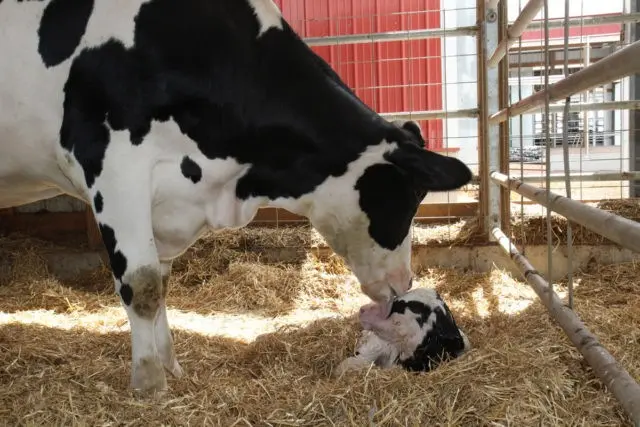Contents
The detection of a cow’s pregnancy at an early stage of pregnancy is the key to the successful bearing of the fetus throughout the entire period. This allows you to provide the animal with the necessary care in a timely manner and create favorable conditions for the birth of healthy offspring. Now there are different ways to determine the pregnancy of a cow by milk, both at home and in the laboratory.

How to check the pregnancy of a cow for milk using folk methods
You can detect the pregnancy of an animal using a simple test at home. The main sign of the onset of pregnancy is a change in the taste of milk, but not every novice breeder will be able to determine this difference. Therefore, you should not trust purely taste buds.
Common folk methods for checking a cow for pregnancy in milk at an early stage.
The first way:
- After 40-50 days after the last insemination, 30-50 ml of milk should be taken, but not from the first and last stream during milking.
- The liquid should settle for 0,5-3 hours at room temperature.
- Separately, pour boiled water, heated to 4 degrees, into a glass glass for 5/40 of the total volume.
- Let it stand a little so that possible impurities sink to the bottom.
- Using a pipette, drop 9-10 drops of selected milk onto the surface of the water from a height of less than 5 cm.
- If the cow is not pregnant, then the milk will quickly dissolve in water and within 5 minutes. the liquid will acquire a uniform white tint.
- If the mating was successful, then milk drops will settle to the bottom of the glass in wavy circles and only eventually mix with water.
The second way:
- Pour fresh milk and pure medical alcohol into a transparent flask, combining the components in equal amounts.
- Shake the container well.
- A dairy product taken from a pregnant cow will curdle within 3-5 minutes, and in the absence of pregnancy, this will happen in 20-40 minutes.
The accuracy of this method, according to experienced breeders, is 70-75%.
At home, determining pregnancy by milk (a video on this topic can be found at the end of the article) does not require the use of special devices, but it does not give a 100% guarantee either. Therefore, to use folk methods or trust professional analysis, each breeder decides for himself.
How to find out the pregnancy of a cow by milk in the laboratory
A more accurate cow pregnancy test for milk can be done in the laboratory. This method allows you to quickly determine pregnancy on the 19th-21st day after the last estrus by the level of steroid hormone in the animal’s milk with an accuracy of 97%.
The level of progesterone has the ability to change cyclically. During the period of ovulation, that is, at the beginning of the sexual cycle, its concentration in cow’s milk is within 2 ng / ml. In the following days, this figure is constantly increasing and on the 13-15th day it reaches 10-20 ng / ml.

Based on this, pregnancy can be detected on the 19-21st day after mating with maximum accuracy. By the concentration of progesterone in milk, one can judge the condition of the cow:
- less than 4 ng / ml – non-pregnant;
- 4-7 ng / ml – the probability is doubtful;
- more than 7 ng / ml – pregnancy has occurred.
To determine pregnancy, it is enough to take milk in the amount of 1,5 ml into prepared test tubes at the last stage of milking. The duration of the analysis is 30 minutes, excluding equipment preparation.
This method has been widely recognized throughout the world, as it is easy to perform and does not require highly qualified laboratory assistant. But it requires special equipment to do so.
The main advantages of enzyme immunoassay of milk:
- helps to quickly identify non-seed cows and return them to reproduction;
- eliminates animal stress compared to other common diagnostic methods;
- reduces the likelihood of repeated mating of inseminated cows showing signs of false hunting.
The ELISA method detects the cow’s pregnancy 40-70 days earlier than a rectal examination, and 10-15 days earlier than the ultrasound method using a special sensor. This allows you to significantly reduce the period of useless waiting.
Conclusion
The use of any of the proposed methods allows you to determine the pregnancy of a cow by milk, but which one to choose, each owner decides for himself. Detecting pregnancy at an early stage is extremely important for obtaining healthy offspring. Indeed, during this period, the animal needs special conditions of maintenance and nutrition, since only in this case can one count on a positive result.









